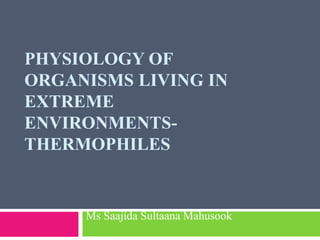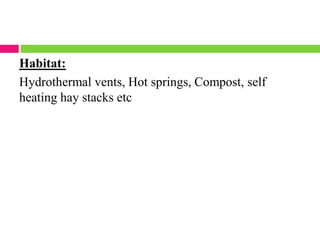PHYSIOLOGY OF ORGANISMS LIVING IN EXTREME ENVIRONMENTS- THERMOPHILES
- 1. PHYSIOLOGY OF ORGANISMS LIVING IN EXTREME ENVIRONMENTS- THERMOPHILES Ms Saajida Sultaana Mahusook
- 2. Extremophiles are organisms that can survive in extreme environmental conditions. Extremophiles include members of all three domains of life, i.e., bacteria, archaea, and eukarya. Although the molecular strategies employed for survival in such environments are still not fully clarified, it is known that these organisms have adapted biomolecules and peculiar biochemical pathways to adapt in extreme environments. They possess enzymes and proteins which remain catalytically active under extremes of temperature, salinity, pH, and solvent conditions.
- 3. Thermophiles are organisms that can thrive in wide range of temperatures. THERMOPHILES Hyperthermophile Growth >80°C Thermus aquaticus, Sulfolobus acidocaldarius Thermophile Growth 60-80°C Bacillus subtilis, Aspergillus fumigatus Mesophile Growth 15-60°C Staphylococcus aureus, Escherichia coli Psychrophile Growth below 15°C or lower Pseudomonas antarctica, Psychrobacter aquaticus
- 4. Habitat: Hydrothermal vents, Hot springs, Compost, self heating hay stacks etc
- 5. Adaptation mechanism of Thermophiles Membrane lipids have ether linkage- more branched, more saturated and are of high molecular weight. These characters increase melting temperature of membrane lipids. Heat shock proteins- has more hydrophobic interiors which prevents unfolding or denaturation at higher temperatures High GC content than AT content in nucleic acid structure. Reverse DNA gyrase enzyme- catalyzes positive supercoiling of closed circular that helps to resist degradation more than negatively supercoiled DNA.
- 6. DNA association with DNA binding histone like protein. Salts like potassium and magnesium are found at higher levels in thermophilic archaea- protect double- stranded DNA from phosphodiester bond degradation. Thick pseudo-crystalline proteinaceous surface layer (S-layer) surrounding cell. Chemotrophic mode of nutrition- Can live without sunlight or organic carbon as food- instead survive on sulfur, hydrogen, iron sulfide and other materials that other organisms cannot metabolize.
- 7. Application Baking, brewing, detergents, Paper bleaching industries.
- 8. Reference: https://www.ncbi.nlm.nih.gov/pmc/articles/PMC418 7170/ https://pdfs.semanticscholar.org/afcb/e822c6154b99 5b5e625f53284f18125e4ca0.pdf https://www.slideshare.net/jyotimatolia/extremophil es-59367883
- 9. Thank You








